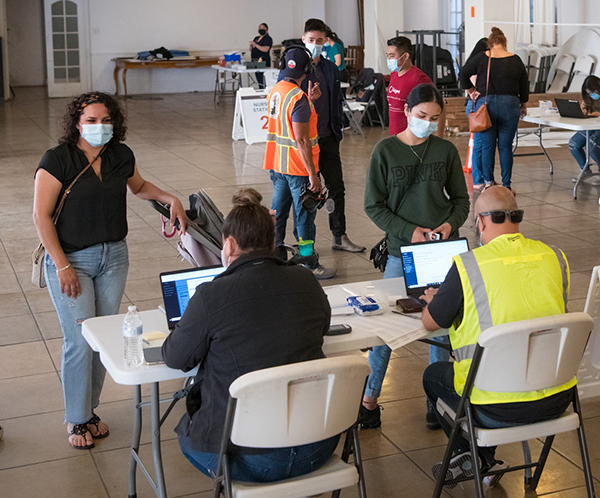Wave Wire Services
LOS ANGELES — Los Angeles County’s weeks-long decline in new COVID-19 case rates stalled April 6 with the release of updated state figures, confirming the county will be unable to advance to the less-restrictive yellow tier of the economic reopening blueprint for three weeks or more.
The state’s weekly update of county-by-county figures put Los Angeles County’s seven-day average daily rate of new COVID-19 infections at 3.1 per 100,000 residents, the same level as last week.
The number leaves the county firmly entrenched in the orange tier of the state’s Blueprint for a Safer Economy, which governs business and recreational restrictions during the pandemic. The county officially entered the orange tier last week, but did not ease its health-order restrictions until April 5.
Advancing to the yellow tier — which would allow a further loosening of capacity restrictions at most businesses — originally required counties to have an average daily new case rate of less than 1 per 100,000 residents. That threshold, however, was eased April 6 to less than 2 per 100,000 residents, thanks to the state meeting the goal of 4 million COVID vaccine doses administered in low-income communities hard hit by the pandemic.
At 3.1 new cases per 100,000 residents, Los Angeles County is still well short of the yellow tier level.
County Public Health Director Barbara Ferrer said April 5 she did not expect the county to reach the yellow-tier level this week. She reiterated the point the next day while addressing the county Board of Supervisors.
She also said she anticipated a leveling off of the county’s rate of new cases, despite several weeks of significant drops, telling the board the metrics likely “will not change significantly this week or next.”
To advance to the yellow tier, the county’s case rate would have to fall below 2 per 100,000 residents and remain there for two consecutive weeks.
That means the earliest Los Angeles County could now qualify for a move would be three weeks — or four weeks if Ferrer’s prediction about next week’s numbers is accurate.
The state updates the county-by-county statistics every Tuesday.
But movement within the tier system is expected to become moot by summer. State health officials and Gov. Gavin Newsom announced April 6 that they will scrap the Blueprint for a Safer Economy on June 15, lifting all of its restrictions and eliminating the tier system — assuming continued supply of vaccines and no spikes in COVID hospitalizations, particularly among people who have been vaccinated.
California Health and Human Services Secretary Dr. Mark Ghaly said the June 15 date was chosen for being two months after COVID-19 vaccines are made available to all Californians aged 16 and over. And the decision to lift all the blueprint requirements comes in response to rising vaccination numbers and continued decreases in all key pandemic-tracking metrics, such as case numbers, positivity rates and hospitalizations.
“With all of that, we are at the stage where we’re ready to consider the next aspect of our pandemic response,” Ghaly said. “The road to this moment hasn’t been easy. We have come together as Californians to save thousands of lives. And now we look at what is beyond that Blueprint for a Safer Economy that has been guiding California’s slow, public-health-minded transition and opening of our economy. … We look to get to that end of the blueprint.”
Ghaly said scrapping the blueprint — which will be done statewide, regardless of where individual counties may be ranked at the time in the tier system — “really means that every day activities will be allowed, and businesses can open with common-sense risk-reduction measures.”
“This means the end to our color-coded tiers,” he said. “You can go to movies, to the beach and see family.”
Ghaly stressed, however, that a statewide mask mandate will remain in place “to prevent illness and promote health.”
He noted that the June 15 date could possibly be adjusted if the state begins over the next two months to experience rises in hospitalization numbers or a sudden lack of vaccine supply. He urged all residents to ensure the move occurs on time by continuing to practice infection-control measures.
The move is predicated largely on the vaccine supply, which has been slowly increasing in the state and county. Los Angeles County this week was allocated nearly 400,000 doses, its highest level to date.
That figure doesn’t include thousands more doses allocated directly to some providers in the county, such as pharmacies, large health care providers and the federally operated vaccination site at Cal State Los Angeles.
Speaking to the Board of Supervisors, Ferrer reiterated that if the county receives an average of 576,000 doses per week — which is roughly in line with projected allocations through the end of this month — it will have capacity to vaccinate 80% of all residents 16 years and older in about 12 weeks, or roughly the end of June.
“We are now vaccinating at an accelerated pace,” Ferrer said, noting that the number of innoculations has roughly doubled at four of the county’s five mega sites.
“We still are not receiving enough doses for what we have capacity for,” she told the board, saying that by the end of this week, the county will have capacity to administer 1 million doses a week.
The county has been working to ramp up its capacity to administer shots in anticipation of increasing supply.
According to state figures, there were 552 people hospitalized due to COVID in Los Angeles County as of April 6, down from 568 the day before. There were 138 people in intensive care, a drop from 144.
Ferrer reported 23 new COVID-19 deaths, raising the countywide death toll since the pandemic began to 23,296.
Another 406 new cases were also reported by the county, lifting the cumulative total from throughout the pandemic to 1,222,802.











